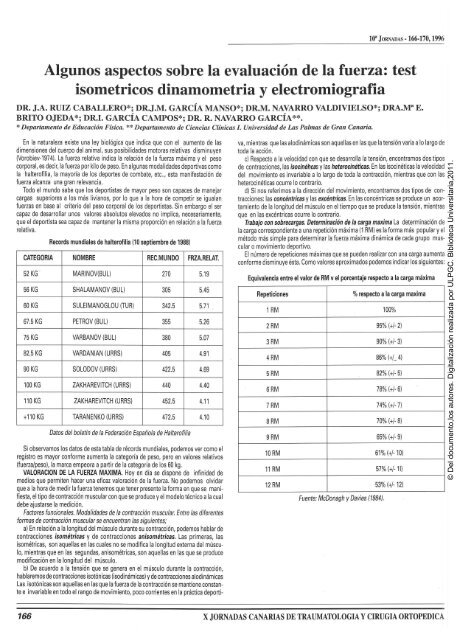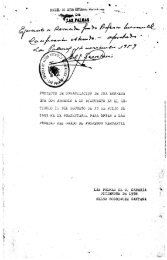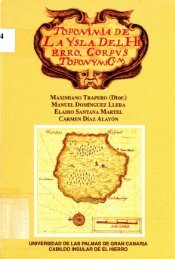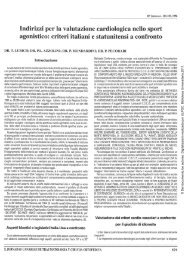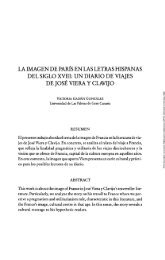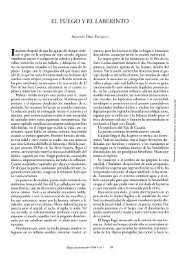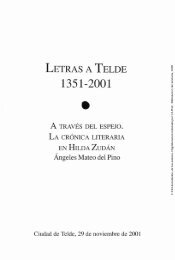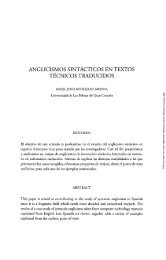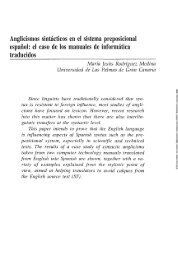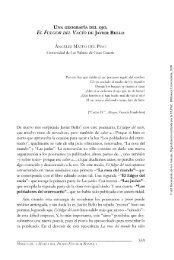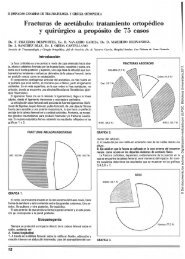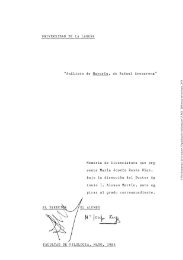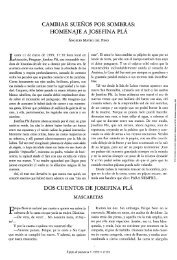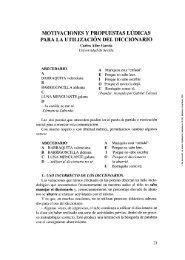Algunos aspectos sobre la evaluación de la fuerza: test isometricos ...
Algunos aspectos sobre la evaluación de la fuerza: test isometricos ...
Algunos aspectos sobre la evaluación de la fuerza: test isometricos ...
You also want an ePaper? Increase the reach of your titles
YUMPU automatically turns print PDFs into web optimized ePapers that Google loves.
10• JORNADAS -166-170, 1996<br />
<strong>Algunos</strong> <strong>aspectos</strong> <strong>sobre</strong> <strong>la</strong> <strong>evaluación</strong> <strong>de</strong> <strong>la</strong> <strong>fuerza</strong>: <strong>test</strong><br />
<strong>isometricos</strong> dinamometria y electromiografia<br />
DR. J.A. RUIZ CABALLERO*; DR.J.M. GARCÍA MANSO*; DR.M. NAVARRO VALDIVIELSO*; DRA.Ma E.<br />
BRITO OJEDA*; DR.I. GARCÍA CAMPOS*; DR. R. NAVARRO GARCÍA**.<br />
*Departamento <strong>de</strong> Educación Física. ** Departamento <strong>de</strong> Ciencias Clínicas l. Universidad <strong>de</strong> Las Palmas <strong>de</strong> Gran Canaria.<br />
En <strong>la</strong> naturaleza existe una ley biológica que indica que con el aumento <strong>de</strong> <strong>la</strong>s<br />
dimensiones <strong>de</strong>l cuerpo <strong>de</strong>l animal, sus posibilida<strong>de</strong>s motoras re<strong>la</strong>tivas disminuyen<br />
(Vorobiev-197 4). La <strong>fuerza</strong> re<strong>la</strong>tiva indica <strong>la</strong> re<strong>la</strong>ción <strong>de</strong> <strong>la</strong> <strong>fuerza</strong> máxima y el peso<br />
corporal, es <strong>de</strong>cir, <strong>la</strong> <strong>fuerza</strong> por kilo <strong>de</strong> peso. En algunas modalida<strong>de</strong>s <strong>de</strong>portivas como<br />
<strong>la</strong> halterofilia, <strong>la</strong> mayoría <strong>de</strong> los <strong>de</strong>portes <strong>de</strong> combate, etc .. , esta manifestación <strong>de</strong><br />
<strong>fuerza</strong> alcanza una gran relevancia.<br />
Todo el mundo sabe que los <strong>de</strong>portistas <strong>de</strong> mayor peso son capaces <strong>de</strong> manejar<br />
cargas superiores a los más livianos, por lo que a <strong>la</strong> hora <strong>de</strong> competir se igua<strong>la</strong>n<br />
<strong>fuerza</strong>s en base al criterio <strong>de</strong>l peso corporal <strong>de</strong> los <strong>de</strong>portistas. Sin embargo el ser<br />
capaz <strong>de</strong> <strong>de</strong>sarrol<strong>la</strong>r unos valores absolutos elevados no implica, necesariamente,<br />
que el <strong>de</strong>portista sea capaz <strong>de</strong> mantener <strong>la</strong> misma proporción en re<strong>la</strong>ción a <strong>la</strong> <strong>fuerza</strong><br />
re<strong>la</strong>tiva.<br />
Records mundiales <strong>de</strong> halterofilia (10 septiembre <strong>de</strong> 1988)<br />
CATEGORIA NOMBRE REC.MUNDO FRZA.RELAT.<br />
52 KG. MARINOV(BUL) 270 5.19<br />
56 KG SHALAMANOV (BUL) 305 5.45<br />
60 KG SULEIMANOGLOU (TUR) 342.5 5.71<br />
67:5 KG PETROV (BUL) 355 5.26<br />
75 KG VARBANOV (BUL) 380 5.07<br />
82.5 KG VARDANIAN (URRS) 405 4.91<br />
90 KG SOLODOV (URRS) 422.5 4.69<br />
100 KG ZAKHAREVITCH (URRS) 440 4.40<br />
110 KG ZAKHAREVITCH (URRS) 452.5 4.11<br />
t110 KG TARANENKO (URRS) 472.5 4.10<br />
Datos <strong>de</strong>l boletín <strong>de</strong> <strong>la</strong> Fe<strong>de</strong>ración Españo<strong>la</strong> <strong>de</strong> Halterofilia<br />
Si observamos los datos <strong>de</strong> esta tab<strong>la</strong> <strong>de</strong> récords mundiales, po<strong>de</strong>mos ver como el<br />
registro es mayor conforme aumenta <strong>la</strong> categoría <strong>de</strong> peso, pero en valores re<strong>la</strong>tivos<br />
(<strong>fuerza</strong>/peso). <strong>la</strong> marca empeora a partir <strong>de</strong> <strong>la</strong> categoría <strong>de</strong> los 60 kg.<br />
VALORACION DE LA FUERZA MAXIMA. Hoy en día se dispone <strong>de</strong> infinidad <strong>de</strong><br />
medios que permiten hacer una eficaz valoración <strong>de</strong> <strong>la</strong> <strong>fuerza</strong>. No po<strong>de</strong>mos olvidar<br />
que a <strong>la</strong> hora <strong>de</strong> medir <strong>la</strong> <strong>fuerza</strong> tenemos que tener presente <strong>la</strong> forma en que se manifiesta,<br />
el tipo <strong>de</strong> contracción muscu<strong>la</strong>r con que se produce y el mo<strong>de</strong>lo técnico a <strong>la</strong> cual<br />
<strong>de</strong>be ajustarse <strong>la</strong> medición.<br />
Factores funcionales. Modalida<strong>de</strong>s <strong>de</strong> <strong>la</strong> contracción muscu<strong>la</strong>r. Entre <strong>la</strong>s diferentes<br />
formas <strong>de</strong> contracción muscu<strong>la</strong>r se encuentran <strong>la</strong>s siguientes;<br />
a) En re<strong>la</strong>ción a <strong>la</strong> longitud <strong>de</strong>l músculo durante su contracción, po<strong>de</strong>mos hab<strong>la</strong>r <strong>de</strong><br />
contracciones isométricas y <strong>de</strong> contracciones anisométricas. Las primeras, <strong>la</strong>s<br />
isométricas, son aquel<strong>la</strong>s en <strong>la</strong>s cuales no se modifica <strong>la</strong> longitud externa <strong>de</strong>l músculo,<br />
mientras que en <strong>la</strong>s segundas, anisométricas, son aquel<strong>la</strong>s en <strong>la</strong>s que se produce<br />
modificación en <strong>la</strong> longitud <strong>de</strong>l músculo.<br />
b) De acuerdo a <strong>la</strong> tensión que se genera en el músculo durante <strong>la</strong> contracción,<br />
hab<strong>la</strong>remos <strong>de</strong> contracciones isotónicas (isodinámicas) y <strong>de</strong> contracciones alodinámicas<br />
Las isotónicas son aquel<strong>la</strong>s en <strong>la</strong>s que <strong>la</strong> <strong>fuerza</strong> <strong>de</strong> <strong>la</strong> contracción se mantiene constante<br />
e invariable en todo el rango <strong>de</strong> movimiento, poco corrientes en <strong>la</strong> práctica <strong>de</strong>porti-<br />
va, mientras que <strong>la</strong>s alodinámicas son aquel<strong>la</strong>s en <strong>la</strong>s que <strong>la</strong> tensión varía a lo <strong>la</strong>rgo <strong>de</strong><br />
toda <strong>la</strong> acción.<br />
e) Respecto a <strong>la</strong> velocidad con que se <strong>de</strong>sarrol<strong>la</strong> <strong>la</strong> tensión, encontramos dos tipos<br />
<strong>de</strong> contracciones, <strong>la</strong>s isocinéhcas y <strong>la</strong>s heterocinéticas. En <strong>la</strong>s isocinéticas <strong>la</strong> velocidad<br />
<strong>de</strong>l movimiento es invariable a lo <strong>la</strong>rgo <strong>de</strong> toda <strong>la</strong> contracción, mientras que con <strong>la</strong>s<br />
heterocinéticas ocurre lo contrario.<br />
d) Si nos referimos a <strong>la</strong> dirección <strong>de</strong>l movimiento, encontramos dos tipos <strong>de</strong> contracciones:<br />
<strong>la</strong>s concéntrícas y <strong>la</strong>s excéntricas. En <strong>la</strong>s concéntricas se produce un aco rtamiento<br />
<strong>de</strong> <strong>la</strong> longitud <strong>de</strong>l músculo en el tiempo que se produce <strong>la</strong> tensión, mientras<br />
que en <strong>la</strong>s excéntricas ocurre lo contrario.<br />
Trabajo con <strong>sobre</strong>cargas. Determinación <strong>de</strong> <strong>la</strong> carga maxima La <strong>de</strong>terminación <strong>de</strong><br />
<strong>la</strong> carga correspondiente a una repetición máxima (1 RM) es <strong>la</strong> forma más popu<strong>la</strong>r y el<br />
método más simple para <strong>de</strong>terminar <strong>la</strong> <strong>fuerza</strong> máxima dinámica <strong>de</strong> cada grupo muscu<strong>la</strong>r<br />
o movimiento <strong>de</strong>portivo.<br />
El número <strong>de</strong> repeticiones máximas que se pue<strong>de</strong>n realizar con una carga aumenta<br />
conforme disminuye ésta. Como valores aproximados po<strong>de</strong>mos indicar los siguientes:<br />
Equivalencia entre el valor <strong>de</strong> RM v el porcentaje respecto a <strong>la</strong> carga máxima<br />
Repeticiones % respecto a <strong>la</strong> carga maxima<br />
1RM 100%<br />
2 RM 95% (+/- 2)<br />
3 RM 90% (+/- 3)<br />
4RM 86% (t/_ 4)<br />
5RM 82% (+/- 5)<br />
6RM 78% (+/- 6)<br />
7RM 74% (+/- 7)<br />
8RM 70% (+/- 8)<br />
9RM 65% (t/- 9)<br />
10 RM 61% (t/-10)<br />
11 RM 57% (t/-11)<br />
12 RM 53% (t/-12)<br />
Fuente: McDonagh y Davies (1984).<br />
166 X JORNADAS CANARIAS DE TRAUMATOLOGIA Y CIRUGIA ORTOPEDICA<br />
© Del documento,los autores. Digitalización realizada por ULPGC. Biblioteca Universitaria,2011.
Equivalencias entre el valor <strong>de</strong> R.My el porcentaje respecto a <strong>la</strong> carga máxima<br />
110<br />
"' 100<br />
N<br />
Q;<br />
90<br />
:::><br />
-Q) 80<br />
"O<br />
Q) 70<br />
·g<br />
e: 60<br />
Q)<br />
2 50<br />
o<br />
a..<br />
40<br />
o<br />
y= 107,72e -0,0568x<br />
R2 = 0,9936<br />
2 4 6<br />
Repeticiones (RM)<br />
<strong>Algunos</strong> <strong>aspectos</strong> <strong>sobre</strong> <strong>la</strong> <strong>evaluación</strong> <strong>de</strong> <strong>la</strong> <strong>fuerza</strong>: <strong>test</strong> <strong>isometricos</strong> dinamometria y electromiografia<br />
8 10 12<br />
No obstante, en el caso <strong>de</strong> adolescentes (o en adultos se<strong>de</strong>ntarios), <strong>la</strong> Aca<strong>de</strong>mia<br />
Americana <strong>de</strong> Pediatría y <strong>la</strong> National Strength and Conditioning Association recomiendan<br />
el uso <strong>de</strong>l1 O RM. Incluso a <strong>la</strong> hora <strong>de</strong> calcu<strong>la</strong>r el1 RM, no todos los entrenadores<br />
están dispuestos a utilizar cargas <strong>de</strong>masiado elevadas durante .un <strong>test</strong>. especialmente<br />
si el <strong>de</strong>portista no está acostumbrado a levantar<strong>la</strong>s. Para solucionar este problema<br />
existen una serie <strong>de</strong> fórmu<strong>la</strong>s y tab<strong>la</strong>s que nos permiten el cálculo a partir <strong>de</strong>l uso <strong>de</strong><br />
cargas submáximas. Algunas <strong>de</strong> estas fórmu<strong>la</strong>s fueron <strong>de</strong>terminadas por Mayhew y<br />
col. (1993), Brzycki (1993) y Lan<strong>de</strong>r (1985):<br />
Mavhew v col. % 1RM = 53.3 t 41.8 x e -oossxrepg<br />
Lan<strong>de</strong>r. %1 RM= 101.3 - 2.67123 x reps.<br />
. Brzyck. %1 RM = 102.78- 2.78 x reps.<br />
Equivalencias entre el número <strong>de</strong> repeticiones y el% respecto al100% <strong>de</strong> <strong>la</strong> <strong>fuerza</strong><br />
máxima:<br />
Equivalencias entre el número <strong>de</strong> repeticionesy el % a que correspon<strong>de</strong> respecto al<br />
100% <strong>de</strong> <strong>la</strong> <strong>fuerza</strong> máxima<br />
REPETICION MAYHEW LANDER BRZVCKI<br />
8 80 80 81<br />
9 79 77 78<br />
10 77 75 75<br />
11 76 72 72<br />
12 75 69 69<br />
13 74 67 67<br />
14 73 64 64<br />
15 72 61 61<br />
16 71 59 58<br />
17 70 56 56<br />
18 69 53 53<br />
19 68 51 50<br />
20 67 48 47<br />
Para sujetos <strong>de</strong> edad avanzada los protocolos que se <strong>de</strong>ben utilizar <strong>de</strong>ben diferenciarse<br />
en su intensidad a los utilizados en pob<strong>la</strong>ciones jóvenes y, <strong>sobre</strong> todo, con los<br />
<strong>de</strong> pob<strong>la</strong>ciones entrenadas A modo <strong>de</strong> ejemplo, po<strong>de</strong>mos ver <strong>la</strong>s ecuaciones que se<br />
pue<strong>de</strong>n emplear para <strong>de</strong>terminar el IRM en dos movimientos concretos (press <strong>de</strong><br />
banca y extensión <strong>de</strong> piernas):<br />
Press <strong>de</strong> banca - IRM = (1 .2991 x 7-IORM)t 4.373 (Brown y col.1995).<br />
Sentadil<strong>la</strong> (mujeres)-1 RM = (1.0778 x 5-10 RM +(2.2419 x nª re p.)+ 10.061 (Guynes y<br />
col. 1995).<br />
Valoración <strong>de</strong> <strong>la</strong> <strong>fuerza</strong> general y parcial en pob<strong>la</strong>ciones se<strong>de</strong>ntarias. Para valorar lo<br />
que Hoeger cfr. George y col. (1996) <strong>de</strong>norninanfitness muscu<strong>la</strong>r, los autores e<strong>la</strong>boran<br />
una tab<strong>la</strong> <strong>de</strong> puntuación para cada ejercicio básico <strong>de</strong> trabajo <strong>de</strong> <strong>fuerza</strong> (curl <strong>de</strong> biceps,<br />
prensa <strong>de</strong> piernas, jalón polea alta, press <strong>de</strong> banco, curl <strong>de</strong> biceps femoral y abdominales<br />
con mano en <strong>la</strong> nuca), en fimción <strong>de</strong>l número <strong>de</strong> repeticiones que el sujeto realiza<br />
<strong>de</strong> acuerdo a su peso corporal y sexo. Para ello se multiplica el peso corporal por un<br />
tanto por ciento individual para cada ejercicio y sexo <strong>de</strong>l ejecutante.<br />
Porcentaje <strong>de</strong> carga a utilizar por cada ejercicio<br />
Ejercicio Hombres Mujeres<br />
Curl Blceps 35 18<br />
Prensa Piernas 65 50<br />
Jalón Polea Alta 70 45<br />
Abdominales (1') - -<br />
Press <strong>de</strong> banco 75 45<br />
Curl Biceps Femoral 32 25<br />
Valoración <strong>de</strong> los ejercicios en <strong>la</strong> bateria <strong>de</strong> fitness muscu<strong>la</strong>r<br />
Hombres<br />
Nivel Puntos Curl biceps Prensa prn Jalón p.a. Press b<strong>la</strong>nco Biceps femoral Abdominal<br />
Muy baja 5
DR. J.A. RUIZ CABALLERO; DRJM. GARCÍA MANSO; DR.M. NAVARRO VALDIVIELSO; DRA.M' E. BRITO OJEDA; DRJ. GARCÍA CAMPOS; DR. R. NAVARRO GARCÍA.<br />
La puntuación obtenida en cada <strong>test</strong> se suma y se aplica <strong>la</strong> siguiente tab<strong>la</strong> <strong>de</strong> <strong>evaluación</strong>:<br />
Tab<strong>la</strong> <strong>de</strong> puntuación fitness muscu<strong>la</strong>r<br />
Nivel Total <strong>de</strong> puntos<br />
Baja 89<br />
Fuente: George y col. (1996).<br />
Esta batería <strong>de</strong> valoración <strong>de</strong> <strong>la</strong> <strong>fuerza</strong> muscu<strong>la</strong>r es válida para pob<strong>la</strong>ciones no altamente<br />
entrenadas, <strong>de</strong>biéndose utilizar ejercicios y tab<strong>la</strong>s <strong>de</strong> valoración in<strong>de</strong>pendientes<br />
para cada modalidad <strong>de</strong>portiva y grupo muscu<strong>la</strong>r.<br />
Valoración <strong>de</strong> los ejercicios básicos <strong>de</strong>l trabajo con <strong>sobre</strong>cargas empleados en <strong>la</strong><br />
<strong>fuerza</strong> máxima De forma global po<strong>de</strong>mos consi<strong>de</strong>rar que los ejercicios básicos que<br />
permiten valorar <strong>la</strong> <strong>fuerza</strong> máxima en gran número <strong>de</strong> modalida<strong>de</strong>s <strong>de</strong>portivas, son<br />
los que se utilizan en el power-lifting: <strong>la</strong> sentadil<strong>la</strong>, el pectoral y el peso muerto. Los<br />
datos que aportamos en <strong>la</strong>s tab<strong>la</strong>s son para sujetos normales no especialmente entrenados<br />
en <strong>fuerza</strong><br />
a) La sentadil<strong>la</strong> o squat. Uno <strong>de</strong> los ejercicios más utilizados en el mundo <strong>de</strong>l entrenamiento<br />
<strong>de</strong>portivo para entrenar o evaluar el trabajo <strong>de</strong> piernas es el <strong>de</strong>nominado<br />
sentadil<strong>la</strong> o squat, el cual viene valorado en <strong>la</strong> obra <strong>de</strong> Legido y col. {1996).<br />
Valoración <strong>de</strong> <strong>la</strong> prueba <strong>de</strong> sentadil<strong>la</strong> (squat)<br />
Valor Hombres Mujeres<br />
100 120 70<br />
90 11 o 60<br />
80 100 50<br />
70 90 40<br />
60 80 30<br />
50 70 20<br />
Fuente: Legido y col. (1996).<br />
b) El pectoral o press <strong>de</strong> banca Este ejercicio es el más utilizado en casi todas <strong>la</strong>s<br />
modalida<strong>de</strong>s <strong>de</strong>portivas para trabajar <strong>la</strong> <strong>fuerza</strong> <strong>de</strong>l miembro superior.<br />
Valoración <strong>de</strong> <strong>la</strong> prueba <strong>de</strong> sentadil<strong>la</strong> (bench press)<br />
Valor Hombres Mujeres<br />
100 72 42<br />
90 66 36<br />
80 60 30<br />
70 54 24<br />
60 48 18<br />
50 42 12<br />
e) El peso muerto. No es un ejercicio <strong>de</strong>masiado utilizado entre los medios <strong>de</strong> trabajo<br />
que habitualmente utilizan los practicantes <strong>de</strong> <strong>la</strong> mayoría <strong>de</strong> <strong>la</strong>s modalida<strong>de</strong>s <strong>de</strong>portivas,<br />
pero sin embargo es un excelente ejercicio para medir <strong>la</strong> <strong>fuerza</strong> máxima<br />
dinámica <strong>de</strong> un sujeto.<br />
Valoración <strong>de</strong> <strong>la</strong> prueba <strong>de</strong> peso muerto<br />
Valor Hombres Mujeres<br />
100 135 80<br />
90 125 70<br />
80 110 55<br />
70 100 45<br />
60 90 35<br />
50 80 25<br />
Tests isométricos. Para <strong>la</strong> ejecución <strong>de</strong> este tipo <strong>de</strong> pruebas con el máximo <strong>de</strong> fiabilidad<br />
y precisión, se necesita <strong>la</strong> utilización un transductor <strong>de</strong> <strong>fuerza</strong> (célu<strong>la</strong>s <strong>de</strong> carga) y,<br />
a ser posible, <strong>de</strong> un soporte informático que ayu<strong>de</strong> en <strong>la</strong> recogida <strong>de</strong> los datos y su<br />
posterior tratamiento. La célu<strong>la</strong> <strong>de</strong> carga nos permite medir <strong>la</strong>s <strong>fuerza</strong>s <strong>de</strong> tracción que<br />
ejerce un sujeto <strong>sobre</strong> un mecanismo preparado para el efecto. Estas medidas se<br />
obtienen a través <strong>de</strong> bandas extensiométricas o transductores insertados <strong>de</strong>ntro <strong>de</strong>l<br />
cuerpo <strong>de</strong> <strong>la</strong> misma. Los componentes básicos <strong>de</strong>l transductor son: Elemento elástico<br />
o estructura <strong>de</strong> acero, al que se aplica <strong>la</strong> tracción y bajo cuya acción sufre <strong>de</strong>formaciones<br />
elásticas lineales, Banda extensiométrica, <strong>la</strong>s cuales, <strong>de</strong>bidamente dispuestas y<br />
alimentadas generan una respuesta eléctrica proporcional a <strong>la</strong> <strong>de</strong>formación producida.<br />
Las bandas extensiométricas son resistencias eléctricas fijadas a <strong>la</strong> estructura <strong>de</strong><br />
acero <strong>de</strong> tal forma que al <strong>de</strong>formarse el acero, éste <strong>de</strong>forma <strong>la</strong> longitud <strong>de</strong>l hilo conductor.<br />
Partiendo <strong>de</strong> <strong>la</strong> fórmu<strong>la</strong>:<br />
1 R=p. 1/s<br />
A partir <strong>de</strong> <strong>la</strong> fórmu<strong>la</strong> es fácil ver que si vana <strong>la</strong> longitud <strong>de</strong>l hilo conductor, su<br />
resistencia variará, <strong>de</strong> tal forma que entre <strong>la</strong> <strong>de</strong>formación <strong>de</strong>l elemento elástico y <strong>la</strong><br />
vanación <strong>de</strong> <strong>la</strong> resistencia <strong>de</strong> <strong>la</strong> banda extensiométrica existe <strong>la</strong> siguiente re<strong>la</strong>ción<br />
lineal:<br />
1 k=(dR/R0)/3 1<br />
Por lo tanto, <strong>de</strong> <strong>la</strong> <strong>de</strong>formación <strong>de</strong>l acero pasan a una variación <strong>de</strong> <strong>la</strong>s resistencias,<br />
<strong>la</strong>s cuales forman un circuito eléctrico simple y bien conocido como es el puente <strong>de</strong><br />
Wheatstone. Al circuito se le suministra una sefial constante <strong>de</strong> entrada proce<strong>de</strong>nte <strong>de</strong><br />
los amplificadores, lo que producirá una señal <strong>de</strong> salida igual o distinta en función <strong>de</strong><br />
<strong>la</strong> variación <strong>de</strong> <strong>la</strong>s resistencias, que irán a un or<strong>de</strong>nador don<strong>de</strong> <strong>la</strong> señal eléctrica se<br />
transforma en una señal analógico-digital utilizando como soporte un programa específicamente<br />
diseñado al efecto. Al margen <strong>de</strong> <strong>aspectos</strong> metodológicos como <strong>la</strong> posición<br />
<strong>de</strong> los segmentos <strong>sobre</strong> los que actúan los músculos que se preten<strong>de</strong>n contro<strong>la</strong>r<br />
o <strong>la</strong> a<strong>de</strong>cuada calibración <strong>de</strong>l aparato, quisiéramos <strong>de</strong>stacar dos <strong>aspectos</strong> fundamen<br />
tales en este tipo <strong>de</strong> valoraciones: (1) <strong>la</strong> duración <strong>de</strong> <strong>la</strong> contracción; (2) el número <strong>de</strong><br />
repeticiones<br />
Con el fin <strong>de</strong> po<strong>de</strong>r alcanzar <strong>la</strong> FMI, es necesario que <strong>la</strong> duración <strong>de</strong> <strong>la</strong> contracción<br />
dure entre 3" y 5" (Hood y col. 1965; Schenk y col. 1965; Murray y col. 1977; An<strong>de</strong>rsen<br />
y col. 1987). Según Hakkinen y col. (1985) el 90% <strong>de</strong> <strong>la</strong> FMI se alcanza a los 2" <strong>de</strong><br />
contracción, aunque <strong>la</strong> experiencia nos <strong>de</strong>muestra que esto varía con los sujetos, su<br />
nivel <strong>de</strong> <strong>fuerza</strong>, su experiencia ante contracciones simi<strong>la</strong>res, el número <strong>de</strong> contracciones<br />
máximas realizadas previamente, etc .... El tiempo que esa FMI no suele <strong>sobre</strong>pasar<br />
<strong>la</strong> duración <strong>de</strong> 1" (Hislop 1963; Murray y col. 1977).<br />
Con el fin <strong>de</strong> que el sistema no <strong>de</strong>tecte «ruidos electrónicos>>, es preciso que el<br />
<strong>de</strong>portista parta <strong>de</strong> un grado mínimo <strong>de</strong> tensión que pue<strong>de</strong> osci<strong>la</strong>r entre el20-30% <strong>de</strong><br />
<strong>la</strong> filerza máxima teórica. No obstante, aunque se aleccione al ejecutante a un <strong>de</strong>sarrollo<br />
rápido <strong>de</strong> <strong>fuerza</strong> <strong>de</strong>s<strong>de</strong> <strong>la</strong> señal <strong>de</strong> comienzo, esta fase inicial presenta un alto<br />
grado <strong>de</strong> variabilidad intrasujeto. <strong>Algunos</strong> autores proponen tarbajar sólo con los<br />
168 X JORNADAS CANARIAS DE TRAUMATOLOGIA Y CIRUGIA ORTOPEDICA<br />
© Del documento,los autores. Digitalización realizada por ULPGC. Biblioteca Universitaria,2011.
DR. J.A. RUIZ CABALLERO; DRJ.M. GARCÍA MANSO; DR.M. NAVARRO VALDIVIELSO; DRA.M' E. BRITO OJEDA; DR.I. GARCÍA CAMPOS; DR. R. NAVARRO GARCÍA.<br />
Dinamometría manual Hombres Mujeres<br />
Muy Bueno 130 kg. + 90 kg.<br />
Normal 120-130 kg. 70-90 kg.<br />
Deficiente -120 kg. -70 kg.<br />
Valoración <strong>de</strong> <strong>la</strong> <strong>fuerza</strong> por medio <strong>de</strong> <strong>la</strong> electromiograra {EMGJ. Las adaptaciones<br />
<strong>de</strong> tipo neural que son provocadas por el entrenamiento <strong>de</strong> <strong>la</strong> <strong>fuerza</strong> sólo pue<strong>de</strong>n ser<br />
estudiadas mediante <strong>la</strong> electromiografia (EMG). ya que es <strong>la</strong> única manera <strong>de</strong> po<strong>de</strong>r<br />
<strong>de</strong>tectar los cambios en <strong>la</strong> activación <strong>de</strong> UM, los cuales son cuantificados por medio<br />
<strong>de</strong> <strong>la</strong> respuesta eléctrica integrada.<br />
El análisis <strong>de</strong> <strong>la</strong> respuesta eléctrica <strong>de</strong> una contracción muscu<strong>la</strong>r nos permite estudiar<br />
también diferentes <strong>aspectos</strong> re<strong>la</strong>cionados con <strong>la</strong> <strong>fuerza</strong> velocidad: <strong>la</strong>tencia <strong>de</strong>l<br />
EMG (LEMG), <strong>la</strong>tencia <strong>de</strong>l dinamograma (LDin.), tiempo <strong>de</strong> transducción electromecánica<br />
(Tte), <strong>fuerza</strong> <strong>de</strong>l primer pico (FPP), tiempo <strong>de</strong>l primer pico (Tpp), <strong>fuerza</strong> máxima<br />
(FM). tiempo <strong>de</strong> <strong>fuerza</strong> máxima (Tfin), tiempo <strong>de</strong> re<strong>la</strong>jación <strong>de</strong>l EMG (TrEMG ), <strong>la</strong>tencia<br />
<strong>de</strong>l dinamograma (LRDin.), tiempo <strong>de</strong> re<strong>la</strong>jación <strong>de</strong>l dinamograma (Tr), <strong>fuerza</strong> <strong>de</strong> re<strong>la</strong>jación<br />
(Fr) (Aionso-1988). A partir <strong>de</strong> estos 11 parámetros es posible <strong>de</strong>terminar diferentes<br />
coeficientes:<br />
Coeficiente <strong>de</strong> explosividad = Fpp 1 (T pp + Tfe) x P<br />
Gradiente. <strong>de</strong> Fuerza Máxima= Fm 1 Tfm x P<br />
Coeficiente <strong>de</strong> re<strong>la</strong>jación = Fr 1 Tr<br />
Bibliografía:<br />
1. ALONSO, J.: Análisis <strong>de</strong> un método polimiográfico para el estudio <strong>de</strong>l músculo en<br />
atletas <strong>de</strong> velocidad >>. Boletín<br />
2. BASMAJIAN, J. V.: Electro-fisiología <strong>de</strong> <strong>la</strong> acción muscu<strong>la</strong> r. Editorial Panamencarna.<br />
Buenos Aires 1976.<br />
3. BOSCO, C, TIHANYI, J. KOMI, PV.,FEKETE, G. APOR, P.: Store and recoil of e<strong>la</strong>shc<br />
energ,v in slow andfast tvpes. Acta Physiol. Svandinavica. 116: 343-349. 1982.<br />
4. BOSCO, C.: La valoración <strong>de</strong> <strong>la</strong> fuena en el <strong>test</strong> <strong>de</strong> Basca .. Barcelona. Paidotribo. 1994.<br />
5. BOSCO, C.: E<strong>la</strong>shcitá musco<strong>la</strong>re e forza esplosiva nelle attivitá fisico-sportiva. Roma.<br />
Societá Stampa Sportiva. 1985.<br />
6. BOSCO, C.: E<strong>la</strong>shcitá musco<strong>la</strong>re e fona explosiva nelle attivitá fisico-sportive. Roma.<br />
Societa Stampa Sportiva. 1985.<br />
7. SOSCO, C.: La valoración <strong>de</strong> <strong>la</strong> fuena con el <strong>test</strong> <strong>de</strong> Bosco. Barcelona. Paidotribo.<br />
1994.<br />
8. SOSCO, C.: TIHANYI, J., KOMI, PV., FEKETE, G. APOR, P.: Sto re and recoil of e<strong>la</strong>shc<br />
energy ín slow andfasttypes of human skeletal muscles. Acta Physiol. Scandinavica.<br />
116: 343-349. 1982.<br />
9. BRITO, E., NAVARRO, M., GARCÍA, A., SANCHEZ, MJ., Gª-MANSO, JM., NAVARRO,<br />
R, RUIZ-CABALLERO, JA.: La condición física <strong>de</strong> <strong>la</strong> pob<strong>la</strong>ción <strong>de</strong> Gran Canaria.<br />
Excmo Cabildo Insu<strong>la</strong>r <strong>de</strong> Gran Canaria. Las Palmas1995<br />
10. CAVAGNA, GA.: MUSCOLO E LOCOMOZIONE. MILÁN. ED. R CORTINa. 1988.<br />
11. CAVAGNA, GA.: Dusman, B. Margaría, R.: Posihve work done by previously streched<br />
muscle. Journal Aplied Physiol. 24: 21-32. 1968.<br />
12. CVAGNA, GA., KOMAREK L., CITIERIO, G., MARGARIA, R.: POWER OUTPUT OF<br />
THE PREVIOUSLY STRETCHED MUSCLE. Medicine and Sport. 6: 159-167. 1971.<br />
13. CAVAGNA, GA, THYS, H., ZAMBONI, A.: The sources of externa! work in level walking<br />
and running. Journal PhysiologyofLondon. 262: 639-657. (1972).<br />
14. CAVAGNA, GA, CITERIO, G.: Force-Velocity re<strong>la</strong>honship of the frog gastrocnemius<br />
shortening in isotenic condihons immediatlely after stretching and from an isometnc<br />
contrachon. Arch. Fisiology. 68:316-318. (1971).<br />
15. CAZORLA, G. LEGER, L., MORINI, JF.: Les epreuves d'effoff en physiologie et mesures<br />
du potenhel anaerohie. Traveux et reserches en EPS nº 7. 28-94. 1984.<br />
16. CAZORLA.: Evaluahon <strong>de</strong> <strong>la</strong> valeur ohvsique. Paris. INSEP. 1984.<br />
17. COMETTI, G.: Les methods mo<strong>de</strong>rnes <strong>de</strong> muscu<strong>la</strong>hon (tomo-1). Dijon. Univ.<br />
Bourbogne. 1989a.<br />
18. COMETII, G.: Les methods mo<strong>de</strong>rnes <strong>de</strong> muscu<strong>la</strong>tion (tomo-2). Dijon. Univ.<br />
Bourbogne. 1989b.<br />
19. COSTILL, DL, DANIELS, J., EVANS, W., FINK, W., KRAHEMBUL, G., SALTIN, B.:<br />
Skeletal muscle enzyrmes and fiber composihon in male andfemale track athletes.<br />
Journal Aplied Physiol. 40: 149-154.1976.<br />
20. GARCÍA-MANSO, J.M.: Comportamiento <strong>de</strong> <strong>la</strong> <strong>fuerza</strong> isométrica máxima ante contracciones<br />
repetidas <strong>de</strong> corta duración y recuperación semiincompleta: Inci<strong>de</strong>ncia<br />
<strong>de</strong>l sexo, <strong>la</strong>s capacida<strong>de</strong>s condicionale y <strong>la</strong>s características morfológicas. Las Palmas.<br />
Tesis Doctora1.1994.<br />
21. GARCÍA MANSO, JM, ORTEGA, FCO., MARTÍN, JM., NAVARRO, M., RUIZ CABA<br />
LLERO, JA, BRITO, E. NAVARRO, E., PALOMINO, A.: Comportamiento <strong>de</strong> <strong>la</strong> producción<br />
<strong>de</strong> <strong>la</strong>ctato p<strong>la</strong>smáhco en contracciones isométricas repetidas. Comparación<br />
entre dos grupos con diferente capacidad <strong>de</strong> trabajo anaeróbico. Congreso<br />
Europeo <strong>de</strong> Medicina <strong>de</strong>l Deporte. Granada. 1995.<br />
22. Gª-MANSO, NAVARRO, M., RUIZ-CABALLERO, JA.: Bases teóricas <strong>de</strong>l entrenamiento:<br />
Principios y Aplicaciones. Madrid Gymnos. 1996.<br />
23. GEORGE, JO., FISHER, AG., VEHRS PR.: Tests y pruebas físicas. Barcelona.<br />
Paidotribo.1996.<br />
24. GONZÁLEZ BADILLO. J.J. Y GOROSTIAGA, E.: Fundamentos <strong>de</strong>l enfrenamiento <strong>de</strong><br />
<strong>la</strong> <strong>fuerza</strong>. Barcelona.ln<strong>de</strong>. 1995.<br />
25. GONZALEZ BADILLO. JJ .: Halterofilia. Madrid COE. 1991.<br />
26. GROSSER, M; HERMANN. H; TUSKER, F; ZINTL, F.: El movimiento <strong>de</strong>potivo. Bases<br />
anatómicas v biomecánicas. Barcelona. Ed. Martin Roca 102-170. 1991.<br />
27. HÁKKINEN K.: Neuromuscu<strong>la</strong>r fahgue and recoverv in male and female athletes<br />
during heavv resistance exercise. lnternational Journal Sports Medicine. 14(2):53-<br />
59. 1993.<br />
28. KORNI, P.: Strength and power in sport. (Oxford) B<strong>la</strong>ckwell Scientific Publications.<br />
1992.<br />
29. LARSSON V COL.: llistochemical and hiochemical changes in human skeletal muscle<br />
with age in se<strong>de</strong>ntary meles, age 22-65 years. Acta Physiol. Scandinava. 46 pp31 -<br />
39. 1978.<br />
30. LEGIDO, C., SEGOVIA IC., BALLESTEROS, JM.: Madrid. Ediciones Pedagógicas.<br />
(1996).Perrin, D.H. lsocinéhca. Elercicios v<strong>evaluación</strong> .. Barcelona. De. Bel<strong>la</strong>terra.<br />
1994.<br />
31. PLATONOV, V.N. La adaptaaón en el <strong>de</strong>porte. Barcelona. Paidotribo.1991.<br />
32. SALTIN B.; GOLLNICK PD.: Skeletal muscle adaptability. significance for metabolism<br />
and performance. Handbook of physiology, Skeletal muscle. Ameerican<br />
Physiological Society 555-631 . 1983.<br />
33. THORSTENSSON, A.: Effect of strength training on enzvme achvites and,ffbre<br />
characterishcs in human skeletal muscle. Acta Physiologica Scandinava. 96:392-<br />
398. 1976.<br />
34. THORSTENSSON, A., GRIMBY, G., KARLSSON.: Force-velocity re<strong>la</strong>hons and fibre<br />
composition in human knee extensor muscles. Journal Aplied Physiology. 40. 12-<br />
16. 1976.<br />
35. VELEZ, M.: El entrenamiento <strong>de</strong> <strong>la</strong><strong>fuerza</strong> <strong>de</strong> salto. Intercambio y estancia en el CAR<br />
Barcelona. 1993.<br />
36. VELEZ, M.: Periodización en el año <strong>de</strong> una competición <strong>de</strong>l máximo nivel. Problemática<br />
<strong>de</strong> <strong>la</strong> pista cubierta en el salto <strong>de</strong> altura. Cua<strong>de</strong>rnos <strong>de</strong> Atletismo. 31. RFEA<br />
1992.<br />
37. VERJOSHANSKI, J. V. Principi <strong>de</strong>l! 'organizzazione <strong>de</strong>ll 'aliena mento nelle discipli<br />
ne di forza veloce, nell 'atletiva leggera. Atleticastudi. 11.-9. 1979.<br />
38. VITIORI, C.: El entrenamiento <strong>de</strong> <strong>la</strong> <strong>fuerza</strong> en el sprint. Atleticastudi. 1-2 3-25. 1990.<br />
(Traducción mecanografiada <strong>de</strong> M. Vélez, Ve<strong>la</strong>, JM. y Galilea, PA).<br />
39. VOROBIEV, AN.: Halterofilia. Ensayo <strong>sobre</strong> fisiología y entrenamiento <strong>de</strong>portivo.<br />
México. Edt. Libros <strong>de</strong> México. 197 4.<br />
40. WEINECK J.: Biologie du sport. Paris. Vigo!. 1992.<br />
41. WELLS, C.L.: The effects of physical activity on cardiorespiratoryfittness in Childre n.<br />
En Effects of phvsical achvitv in children. American Aca<strong>de</strong>rny of P.E. papers. 19:<br />
114-126. 1985.<br />
42. WELLS, C.L. WOMEN. Sport and Performance. A Phvsiological Perspechve.<br />
Champaign, IL. Human Kinetics 239-249. 1985.<br />
43. TRAININGPROGRAM. Med. Science Sports, 6:133. 1974.<br />
44. WILSON, G.J. The use of e<strong>la</strong>shc energ,v in sport. Sport Coach 13.3:8-10. 1990.<br />
45. ZATZIORSKI,V.M. Metrología Deportiva Moscú. P<strong>la</strong>neta. 1989.<br />
170 X JORNADAS CANARIAS DE TRAUMATOLOGIA Y CIRUGIA ORTOPEDICA<br />
© Del documento,los autores. Digitalización realizada por ULPGC. Biblioteca Universitaria,2011.


